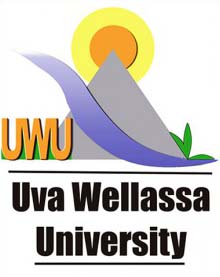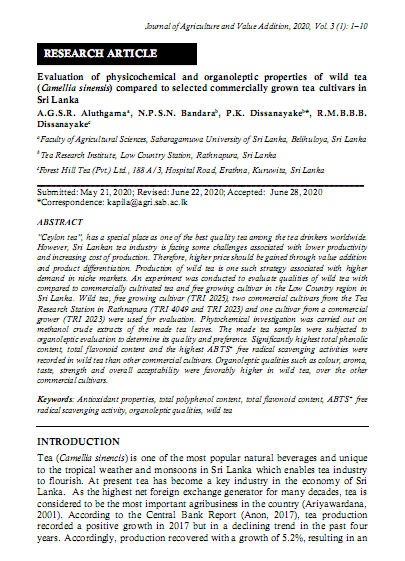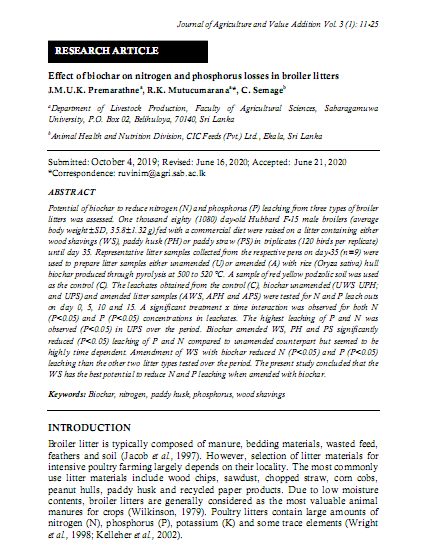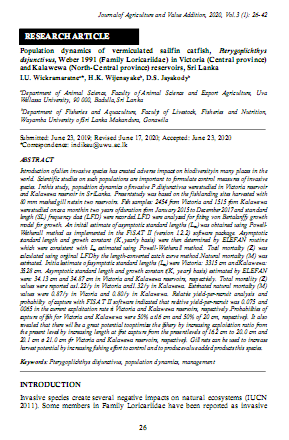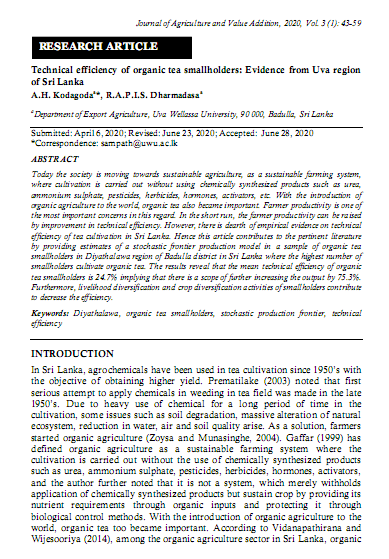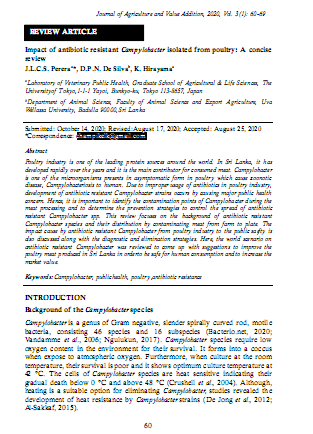
Volume 03 Issue 01
RESEARCH ARTICLES
01. Evaluation of physico-chemical and organoleptic properties of wild tea (Camellia sinensis) compared to selected commercially grown tea cultivars in Sri Lanka
A.G.S.R. Aluthgamaa, N.P.S.N. Bandarab, P.K. Dissanayakeb*, R.M.B.B.B. Dissanayakec
INFORMATION
Journal Title: Journal of Agriculture and Value Addition
Volume : 3 Issue 01
Page : 1- 10
Submitted: May 21, 2020; Revised: June 22, 2020; Accepted: June 28, 2020
*Correspondence: kapila@agri.sab.ac.lk
ABSTRACT
“Ceylon tea”, has a special place as one of the best quality tea among the tea drinkers worldwide. However, Sri Lankan tea industry is facing some challenges associated with lower productivity and increasing cost of production. Therefore, higher price should be gained through value addition and product differentiation. Production of wild tea is one such strategy associated with higher demand in niche markets. An experiment was conducted to evaluate qualities of wild tea with compared to commercially cultivated tea and free growing cultivar in the Low Country region in Sri Lanka. Wild tea, free growing cultivar (TRI 2025), two commercial cultivars from the Tea Research Station in Rathnapura (TRI 4049 and TRI 2023) and one cultivar from a commercial grower (TRI 2023) were used for evaluation. Phytochemical investigation was carried out on methanol crude extracts of the made tea leaves. The made tea samples were subjected to organoleptic evaluation to determine its quality and preference. Significantly highest total phenolic content, total flavonoid content and the highest ABTS+ free radical scavenging activities were recorded in wild tea than other commercial cultivars. Organoleptic qualities such as colour, aroma, taste, strength and overall acceptability were favorably higher in wild tea, over the other commercial cultivars.
02. Effect of biochar on nitrogen and phosphorus losses in broiler litters
J.M.U.K. Premarathnea, R.K. Mutucumaranaa*, C. Semageb
INFORMATION
Journal Title: Journal of Agriculture and Value Addition
Volume : 3 Issue 01
Page : 11- 25
Submitted: October 4, 2019; Revised: June 16, 2020; Accepted: June 21, 2020
*Correspondence: ruvinim@agri.sab.ac.lk
ABSTRACT
Potential of biochar to reduce nitrogen (N) and phosphorus (P) leaching from three types of broiler litters was assessed. One thousand eighty (1080) day-old Hubbard F-15 male broilers (average body weight±SD, 35.8±1.32 g) fed with a commercial diet were raised on a litter containing either wood shavings (WS), paddy husk (PH) or paddy straw (PS) in triplicates (120 birds per replicate) until day 35. Representative litter samples collected from the respective pens on day-35 (n=9) were used to prepare litter samples either unamended (U) or amended (A) with rice (Oryza sativa) hull biochar produced through pyrolysis at 500 to 520 °C. A sample of red yellow podzolic soil was used as the control (C). The leachates obtained from the control (C), biochar unamended (UWS UPH; and UPS) and amended litter samples (AWS, APH and APS) were tested for N and P leach outs on day 0, 5, 10 and 15. A significant treatment x time interaction was observed for both N (P<0.05) and P (P<0.05) concentrations in leachates. The highest leaching of P and N was observed (P<0.05) in UPS over the period. Biochar amended WS, PH and PS significantly reduced (P<0.05) leaching of P and N compared to unamended counterpart but seemed to be highly time dependent. Amendment of WS with biochar reduced N (P<0.05) and P (P<0.05) leaching than the other two litter types tested over the period. The present study concluded that the WS has the best potential to reduce N and P leaching when amended with biochar.
03. Population dynamics of vermiculated sailfin catfish, Pterygoplichthys disjunctivus , Weber 1991 (Family Loricariidae) in Victoria (Central province) and Kalawewa (North-Central province) reservoirs, Sri Lanka
I.U. Wickramaratnea*, H.K. Wijenayakeb, D.S. Jayakodyb
INFORMATION
Journal Title: Journal of Agriculture and Value Addition
Volume : 3 Issue 01
Page : 26- 42
Submitted: June 23, 2019; Revised: June 17, 2020; Accepted: June 23, 2020
*Correspondence: indikau@uwu.ac.lk
ABSTRACT
Introduction of alien invasive species has created adverse impacts on biodiversity in many places in the world. Scientific studies on such populations are important to formulate control measures of invasive species. In this study, population dynamics of invasive P. disjunctivus were studied in Victoria reservoir and Kalawewa reservoir in Sri Lanka. Present study was based on the fish landing sites harvested with 80 mm meshed gill nets in two reservoirs. Fish samples: 2454 from Victoria and 1515 from Kalawewa were studied once a month in two years of duration from January 2015 to December 2017 and standard length (SL) frequency data (LFD) were recorded. LFD were analyzed for fitting von Bertalanffy growth model for growth. An initial estimate of asymptotic standard lengths (L∞) was obtained using Powell- Wetherall method as implemented in the FiSAT II (version 1.2.2) software package. Asymptotic standard length and growth constant (K, yearly basis) were then determined by ELEFAN routine which were consistent with L∞ estimated using Powell-Wetherall method. Total mortality (Z) was calculated using original LFD by the length-converted catch curve method. Natural mortality (M) was estimated. Initial estimate of asymptotic standard lengths (L∞) were Victoria: 33.15 cm and Kalawewa:35.28 cm. Asymptotic standard length and growth constant (K, yearly basis) estimated by ELEFAN were: 34.13 cm and 34.87 cm in Victoria and Kalawewa reservoirs, respectively. Total mortality (Z) values were reported as 1.22/y in Victoria and 1.32/y in Kalawewa. Estimated natural mortality (M) values were 0.87/y in Vicoria and 0.80/y in Kalawewa. Relative yield-per-recruit analysis and probability of capture with FISAT II software indicated that relative yield-per-recruit was 0.075 and 0.065 in the current exploitation rate in Victoria and Kalawewa reservoirs, respectively. Probabilities of capture of fish for Victoria and Kalawewa were 50% at 16 cm and 50% of 20 cm, respectively. It also revealed that there will be a great potential to optimize the fishery by increasing exploitation ratio from the present levels by increasing length at first capture from the present levels of 16.2 cm to 20.0 cm and 20.1 cm to 21.0 cm for Victoria and Kalawewa reservoirs, respectively. Gill nets can be used to increase harvest potential by increasing fishing effort to control and to produce value added products this species.
04. Technical efficiency of organic tea smallholders: Evidence from Uva region of Sri Lanka
A.H. Kodagodaa*, R.A.P.I.S. Dharmadasaa
INFORMATION
Journal Title: Journal of Agriculture and Value Addition
Volume : 3 Issue 01
Page : 43- 59
Submitted: April 6, 2020; Revised: June 23, 2020; Accepted: June 28, 2020
*Correspondence: sampath@uwu.ac.lk
ABSTRACT
Today the society is moving towards sustainable agriculture, as a sustainable farming system, where cultivation is carried out without using chemically synthesized products such as urea, ammonium sulphate, pesticides, herbicides, hormones, activators, etc. With the introduction of organic agriculture to the world, organic tea also became important. Farmer productivity is one of the most important concerns in this regard. In the short run, the farmer productivity can be raised by improvement in technical efficiency. However, there is dearth of empirical evidence on technical efficiency of tea cultivation in Sri Lanka. Hence this article contributes to the pertinent literature by providing estimates of a stochastic frontier production model in a sample of organic tea smallholders in Diyathalawa region of Badulla district in Sri Lanka where the highest number of smallholders cultivate organic tea. The results reveal that the mean technical efficiency of organic tea smallholders is 24.7% implying that there is a scope of further increasing the output by 75.3%. Furthermore, livelihood diversification and crop diversification activities of smallholders contribute to decrease the efficiency.
05. Impact of antibiotic resistant Campylobacter isolated from poultry: A concise review
J.L.C.S. Pereraa*, D.P.N. De Silvab, K. Hirayamaa
INFORMATION
Journal Title: Journal of Agriculture and Value Addition
Volume : 3 Issue 01
Page : 60- 69
Submitted: October 14, 2020; Revised: August 17, 2020; Accepted: August 25, 2020
*Correspondence: champikelk@gmail.com
ABSTRACT
Poultry industry is one of the leading protein sources around the world. In Sri Lanka, it has developed rapidly over the years and it is the main contributor for consumed meat. Campylobacter is one of the microorganisms presents in asymptomatic form in poultry which cause zoonotic disease, Campylobacteriosis to human. Due to improper usage of antibiotics in poultry industry, development of antibiotic resistant Campylobacter strains occurs by causing major public health concern. Hence, it is important to identify the contamination points of Campylobacter during the meat processing and to determine the prevention strategies to control the spread of antibiotic resistant Campylobacter spp. This review focuses on the background of antibiotic resistant Campylobacter species and their distribution by contaminating meat from farm to plate. The impact cause by antibiotic resistant Campylobacter from poultry industry to the public safety is also discussed along with the diagnostic and elimination strategies. Here, the world scenario on antibiotic resistant Campylobacter was reviewed to come up with suggestions to improve the poultry meat produced in Sri Lanka in order to be safe for human consumption and to increase the market value.

